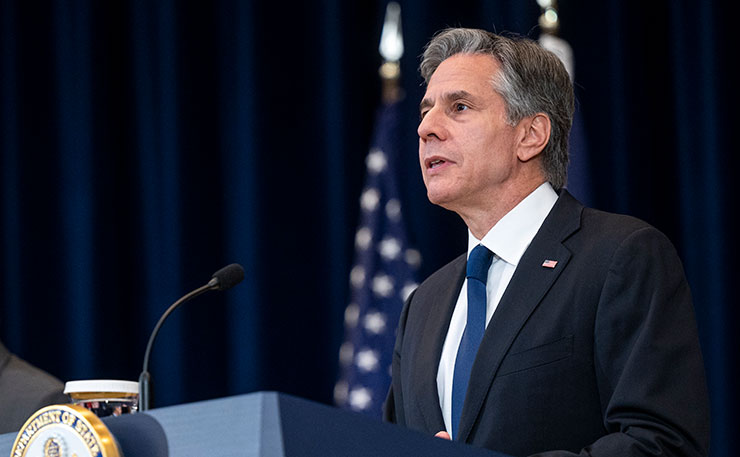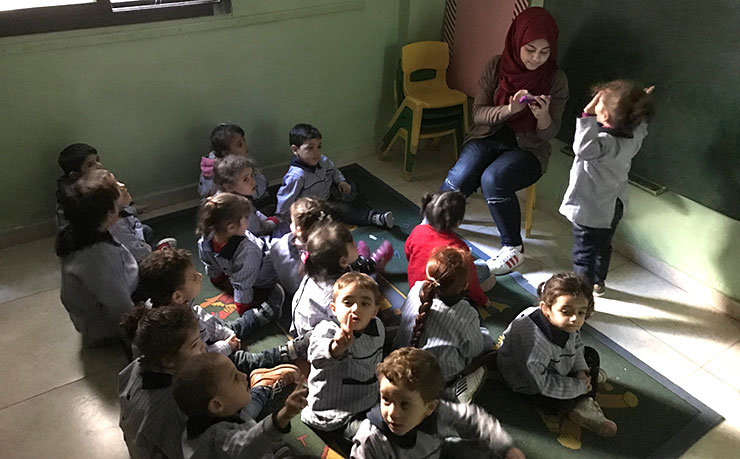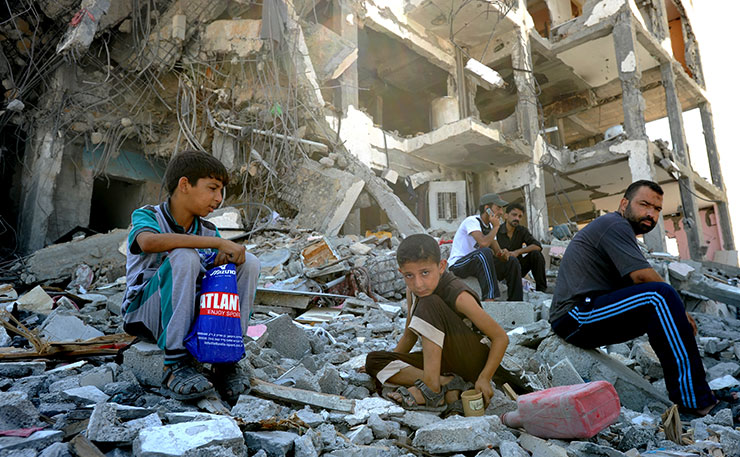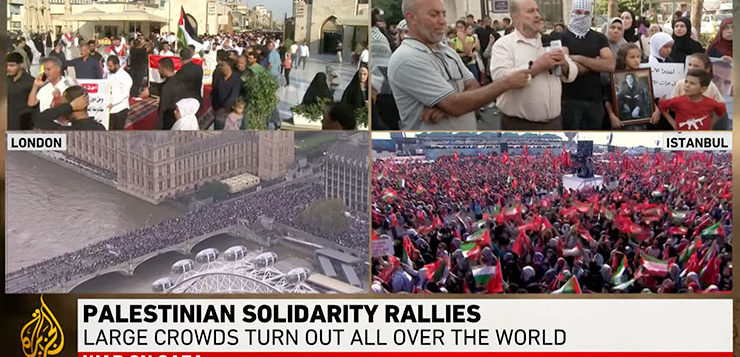Within the rubble of Gaza, and the long history of the Israeli-Palestinian conflict, lies the solutions for peace, writes Kylie Grace.
Since sunset on Friday 28 October, Israel has expanded its aggression on Gaza with a reported anticipation of the imminent ground invasion. This coincides with a complete shutdown of all communication networks in northern Gaza. At the same time, Israeli officials claimed that Hamas headquarters exists beneath the ground of al-Shifa Hospital, Gaza’s largest hospital and refuge to thousands of displaced people.
The only knowledge of what is happening now inside the northern end of Gaza is from the outside vision of the skyline exploding with airstrikes. It’s reported to be the most aggressive attack yet since the commencement of the perpetual massacres during the past weeks. The Director of Red Crescent in Palestine has advised that there are approximately 300,000 civilians remaining in the northern end of Gaza, unable to leave.
The ongoing failed attempts for the UN Security Council to reach a binding Resolution on the situation in Gaza is illustrative of the total collapse of International law, particularly on this issue. The permanent members; Russia, France, the UK, US and China collectively are arguably the world’s greatest instigators of war, and yet we somehow continue to rely on them to establish the conditions for peace.
We close our ears to the screaming voices of Gazans bellowing out from beneath the rubble and instead, shift our attention towards official government narratives and accept the inability of the world’s leaders to agree to a ceasefire to the carpet bombing of two million people. In the past hours, the UN General Assembly has passed a resolution for an ‘immediate humanitarian truce’. Unfortunately, resolutions passed by the General Assembly are not binding, nor was it supported by the United States which acts in direct partnership with Israel.
The US Secretary of State, Antony Blinken, has been calling only for ‘humanitarian pauses’ to the weeks-long bombardment to enable the brief distribution of aid, and, supposedly, to ensure that civilians can ‘get out of harm’s way’. The rhetoric of Blinken’s discourse is entirely inconsistent with the reality of the situation in Gaza.

For weeks now, trucks have lined up at Rafah Crossing, on Gaza’s southern border with Egypt, whilst Israel has restricted the adequate entry of the most basic human needs of food, water and medicine so desperately needed by the besieged population. The leaflet drop by Israel on October 13 ordering Palestinians to evacuate the Northern end of Gaza, and the subsequent drop a week later declaring that “anyone who chooses not to leave… may be determined as an accomplice in a terrorist organisation” is prelude to the indiscriminate killing of civilians.
The suggestion that 1.1 million Palestinians can somehow to relocate themselves to the south of Gaza is not logistically viable. For instance, to walk from Jabaliya, Gaza’s largest refugee camp, down to Khan Younis, it would take approximately 7 hours through rubble, destroyed roads and relentless military bombardment. It is simply not possible for the elderly, or families with many small children to do this, especially in the absence of food and water.
Besides a lack of money for transport, the prevention of fuel from entering Gaza has now left vehicles immobile. The initial reluctance of many people to leave was due to the fear of permanent displacement, given Israel’s recurring suggestions, reiterated by Trump’s ‘Deal of the Century’ in 2019, that Palestinians should be relocated from Gaza into the Egyptian Sinai Desert.
The current evacuation order has ignited visions spurred by the intergenerational trauma engrained within the entire Palestinian psyche as a result of the Nakba, the forced displacement from their historical lands during the ethnic cleansing of Palestine in 1948.
During November 1947, UN Resolution 181 ordered the partition of Palestine into separate Jewish and Arab States, whereby the Jewish population, which at that time a minority, was allocated the majority of historic Palestine, including most of the coastal and fertile farming land. This resolution fulfilled the promise previously made by the British Government in 1917 that offered support to the Zionist Federation for the establishment of a ‘national home for the Jewish people’ in Palestine. This aspiration was made with complete disregard for the existing Palestinian communities and was effectively comparable to the British pretence of ‘terra nullius’ upon the commencement of settler colonialism in Australia.
By the end of 1948, 52 per cent of the Palestinian population had been expelled by Zionist militias, coinciding with an order for Palestinians to evacuate their homes until after the fighting had ceased. In the next breath, the newly created State of Israel established the ‘Absentee laws’ preventing Palestinians ‘who fled’ to ever return to their homes. At the same time, Israel also established the ‘Law of Return’ extending an entitlement for the world’s Jewish population to migrate permanently to Israel.
These events resulted in the permanent displacement of Palestinians and their descendants, millions of whom continue to live in refugee camps across Lebanon, Syria, Jordan, West Bank and Gaza.

The UN Relief and Works Agency, which is the dedicated organisation that provides humanitarian aid to Palestinian refugees, currently identifies that more than 80 per cent of Gaza – 1.7 million of the 2.1 million people – are UN classified refugees as a direct result of displacement in 1948, and the continued expansion of Israel’s undeclared borders.
Furthermore, Palestinian refugees are excluded from protection under the 1951 Refugee Convention, due to the existence of UNRWA, which unfortunately is set up only for education, medical and other basic human needs, not to facilitate the resettlement of Palestinian refugees.
This ongoing injustice is echoed by the current calls from Blinken to extend some minor windows for aid, with complete disregard for the right to protection for Palestinians in Gaza. This is the perpetual nightmare for Palestinians who are consistently denied their basic human rights and offered rations of food and water to keep them barely alive within the continued horror of their existence.
A personal reflection
During my visit to Gaza in 2018, I observed the severity of this existence within a relatively ‘quiet’ time which I can only describe as silent oppression. In the absence of physical military aggression the evidence of structural violence was demonstrated in every corner of Gaza. I worked on a project with the Gaza Community Mental Health Program supporting young children in Khan Younis whose parents had been injured or killed in the 2018 Great March of Return. This had been a protest of Palestinians who were fed up with the oppressive conditions imposed by the debilitating Israeli siege on Gaza that continues to restrict their ability to connect with the outside world.
Back then, the youth unemployment rate was 60 per cent, ground water was irreversibly contaminated with salt and sewage, and the health system was collapsing. A UN report in 2018, had warned that Gaza would be unliveable by 2020, and today that threshold has well and truly been passed.
On March 30, 2018 protesters marched to the Israeli border with the idea of returning home to the land that their families had been expelled from in 1948, with a belief that perhaps in large numbers, the Israeli soldiers could not manage to kill them all. Israeli snipers lined the Gaza boundary, and as unarmed Palestinians moved into the restricted buffer zone, the Israelis opened fire on them, killing more than 70 people in the first 30 minutes.
The border protests extended weeks, resulting in the death of approximately 215 Palestinians, including 46 children. Yet this demonstration achieved nothing, as the voices of Palestinians are constantly ignored by the international community.
The greatest hypocrisy
The current official call for adherence to international law is the greatest hypocrisy. There has been ample opportunity to ensure the protection of Israeli and Palestinian communities through the compliance of human rights and humanitarian laws, as well as endless UN Resolutions that have been created to direct the actions on this conflict. Yet, Israel has never demonstrated any desire to comply.
In December 1948, the UN passed Resolution 194, stating that Palestinian “refugees wishing to return to their homes and live in peace with their neighbours should be permitted to do so… and compensation should be paid to those choosing not to”.
In 1967, UN Resolution 242 called for the withdrawal of Israeli armed forces from the territories it occupied in the 1967 conflict. In 2016, the UN Security Council, then supported by US president Barack Obama, passed Resolution 2334 which condemned Israeli settlements in the West Bank and demanded all settlement construction to cease.
Israel ignored the world and instead accelerated the illegal expansion of settlements. The goal was to increase ‘facts on the ground’ to enable the expansion of Israel’s control of Palestinian lands in the West Bank.
The Israeli government consistently commits these breaches in part because of the immeasurable imbalance of power it holds over the Palestinians. More significantly, regardless of the atrocities it commits, Israel is able to continue breaching international law because of the unwavering support it receives from the United States, which uses its veto powers in the Security Council to protect Israel’s illegal settler colonial agenda.
No vacuum
On October 24, the UN Secretary-General, Antonio Guterres, was criticised for stating that the barbarous attacks by Hamas on 7 October “did not happen in a vacuum”, referring directly to the decades of “suffocating occupation” that has continued to shatter Palestinian “hopes for a political solution”. In this moment, it should also be remembered that in 2017, Hamas leaders extended considerable efforts towards diplomacy in their amended Charter, which outlined the details of their demands on the Israeli government.
The main essence of these demands was: “the establishment of a fully sovereign and independent Palestinian state, with Jerusalem as its capital along the lines of the 4th of June 1967, with the return of the refugees.”
They also expressed their belief that “the establishment of Israel is entirely illegal and contravenes the inalienable rights of the Palestinian people… it is also in violation of human rights that are guaranteed by international conventions, foremost among them is the right to self-determination.”
The contention here remains evident, yet through the call for a Palestinian State on 1967 borders, not even that partitioned by the UN in 1948, they indirectly suggest their openness to the recognition of the Israeli State. We will never know if this shift in Hamas protocol was an opportunity for negotiations, as no genuine negotiation was ever attempted. It appears that the real ‘vacuum’ has been that of the time that has lapsed in which the international community has failed, or refused, to act.
As Palestinian voices grow louder on deaf ears, the heat has accumulated in the pressure cooker which is Gaza, occasionally releasing some steam, often with rocket fire over the buffer zone. More commonly than not, rocket attacks into Israel are instigated by a smaller faction in Gaza, Islamic Jihad, who persist to aggravate Israel until ordered by Hamas to cease.

However, the border skirmish has regularly escalated into, until now, what had appeared to be major military operations: Operation Cast Lead in 2008; Operation Pillar of Defence in 2012; Operation Protective Edge in 2014; Operation Guardian of the Walls in 2021. Tensions have remained in between operations, and all resulting in the deaths of hundreds or thousands of people.
This does not include the hundreds of Palestinians that are killed each year in the West Bank. This year alone, and prior to October 7, more that 280 Palestinians, including 29 children, were killed by either the Israeli army or settlers in violent attacks. In the past weeks, at least an additional 100 people in the West Bank have been killed.
Ways forward
It is also important to realise that Hamas does not influence the West Bank, so the removal of Hamas in Gaza, if even possible, will not resolve the problems of the conflict. The structural violence of the illegal Israeli military occupation will continue and the demands for the rights of Palestinians will remain the same.
However, it is inevitable that the problems for Palestinian refugees will become worse, given that Israel has already destroyed half of the homes across the entire Gaza Strip, and the level of resentment that is likely to emerge following the current annihilation of Gaza will no doubt increase. Furthermore, the majority of Hamas leaders live overseas, out of harm’s way, and the replacement of al-Qassam fighters will not be impossible, particularly given the current state of instability across all of Palestine.
There is, of course, more constructive options to building peace than the current carnage, and options that must not include the passive submission to Israel’s siege and military occupation. The first step is acknowledging that ‘peace’ is not an unfathomable destination, but a process of engaging in consistent peaceful actions where the basic needs of the communities are enabled and respected.
This process should be implemented within the boundaries of international law, including the existing UN Resolutions that aim to direct the outcomes for the most difficult issues in this conflict, specifically relating to the political borders, settlement expansion and a solution for the millions of Palestinian refugees. To claim to be searching for ‘peace’ anywhere outside of these constraints can only be observed as avoiding a solution to fuel alternative self-serving political agendas.
There has never been a genuine process for reconciliation that has addressed the core issues of the conflict, where the human rights and aspirations of all community members have been considered. The Oslo Peace Accords signed in the mid-1990’s may have been the closest consideration of this, yet the immense imbalance of power held by Israel along with the absence of adequate protections for Palestinian human rights resulted in the illegal expansion of Israeli settlements and a broadening of the military control.
Today, in the absence of Hamas, the West Bank is crippled by a debilitating occupation, which the UN and other human rights experts have consistently labelled as ‘Apartheid’.
A possible model for consideration may relate to the centuries-long conflict that existed in Northern Ireland, which presented a similar struggle involving devastating economic destruction, displacement and a systematic takeover of the land by force. The physical violence had proceeded to escalate after the partition of Northern Ireland in 1921, which instilled systematic discrimination, loss of identity and decades of suffering.

A significant similarity to Israel and Palestine was the existence of the IRA, which Britain had declared to be a terrorist organisation. The success of the Belfast Agreement in 1998, can be partly attributed to the role played by former US president Bill Clinton, who acted as a neutral mediator in facilitating the final negotiations. He insisted on the inclusion of the IRA, and refuted the previous preconditions for disarmament. This condition to disarm, similar to Israel’s demands on Hamas, had been a longstanding prevention of dialogue.
However, Clinton managed to incorporate the IRA’s motivations for violence into the peace process and transformed the core issues of the conflict into a workable solution that resulted in collaborative political support and the eventual voluntary disarmament of the IRA. This was the turning point that enabled a real opening for reconciliation initiatives.
In terms of Israel and Palestine, it might now be presumed that in there is too much blood under the bridge, yet it should not be underestimated that a collaborative process of transformative justice can achieve peaceful outcomes when there is a real genuine desire for a resolution. This has been demonstrated in Rwanda, which now experiences sustainable peace in the shadow of the 1994 genocide that resulted in the death of more than 11% of the population. However, any sustainable peace requires the commitment from all parties, and at a minimum, for them to commit to international human rights and humanitarian laws.
The urgent action that is required now, to prevent a global expansion of this sensitive conflict, is an immediate ceasefire to restore order in the region and to prevent any more unnecessary deaths. By ignoring the severity of this current escalation, world leaders walk a dangerous line of awaking a situation that may spiral far out of their control.
It should not be mistaken that this is possibly the most protracted conflict in history, and if the whole world becomes involved this leaves us in an extremely complex position. Leaders cannot continue to react out of rage and revenge as we will continue to keep missing the opportunities for a peaceful resolution.
Peace cannot emerge out of a destructive war, it can only evolve out of silence, which is subtle enough to hear the sound of another person’s voice, even if it is just the whisper of a child from beneath the rubble.
In the absence of restraint, no party can ever ‘win’ anything. The only thing that is guaranteed will be a disastrous loss which will no doubt be experienced by everyone involved.
Donate To New Matilda
New Matilda is a small, independent media outlet. We survive through reader contributions, and never losing a lawsuit. If you got something from this article, giving something back helps us to continue speaking truth to power. Every little bit counts.




